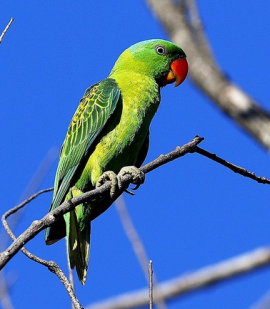Blue-naped Parrot |
|
|
Also known as: Blue-crowned Green Parrot, Luzon Parrot, Philippine Green Parrot
Photos
View in GalleryDid You Know?
The distinctive red beak of the Blue-naped Parrot is red in babies before they are feathered.Academic Research
Related publications: Tanygnathus lucionensisSpecies Profile
Genus: Tanygnathus | Species: lucionensis
Size:
31cm (12.1 in)
Weight:
200-230g (7-8.1 oz)
Subspecies including nominate:
three: T.l. lucionensis, T.l. hybridus, T.l. talautensis
Colour Adult:
T.l. lucionensis: Both adults-back of crown to back of head blue; median wing coverts margined yellow/orange; back washed with blue. Eye yellow.
T.l. hybridus: Both adults-as in lucionensis, but back of crown green and back of head paler blue tinged with violet.
T.l. talautensis (includes salvadorii): Both adults-as in lucionensis but back without blue.
Colour Juvenile:
T.l. lucionensis: As in adult but with little blue on hindcrown to nape; wing coverts green. Eye grey.
Call:
Variety of calls including a repeating aaa-kkk or ak-a-eee with an upward inflection, plus repeated kek-a-kee and drawn-out eeee and other loud, harsh sounds.
Listen NowVideo Links:
Video 1 | Video 2More Information:
Content Sources:
CITES
BirdLife International
Cornell Lab of Ornithology/Birds of the World
Parrots: A Guide to Parrots of the World, Juniper and Parr, 1998
Parrots: Status Survey and Conservation Plan 2000-2004, Snyder, McGowan, Gilardi and Grajal, 2000.
ML Media Collection Catalogue 38699, Blue-naped Parrot Tanygnathus lucionensis, Kennedy, Robert, Biliran, Philippines, Apr. 9 1981, Cornell Lab of Ornithology. Site
Parrots of the World, Forshaw and Cooper, 1977, 1989. 2010 edition
Parrots of the World, Forshaw, 2006.
Parrots in Aviculture, Low, 1992.
Photos
View in GalleryDid You Know?
The distinctive red beak of the Blue-naped Parrot is red in babies before they are feathered.Academic Research
Related publications: Tanygnathus lucionensisSpecies Care
Captive Status:
Not usually seen in captivity outside of the Philippines.
Longevity:
Not recorded.
Housing:
Walk-in aviary, minimum length 3m (9.8 ft).
Diet:
Mix of small seeds: canary, oats, safflower; spray millet; limited sunflower seed, dry, soaked or sprouted; sprouted mung or other beans, cooked butterbeans or lentils; boiled corn; fresh green leaves (Swiss chard, lettuce, sowthistle, dandelion, chickweed, etc); vegetables including carrot, celery, zucchini, squash, green beans and peas in the pod; fruit including apple, pear, orange, cactus fruits, bananas; nuts such as walnuts, hazelnuts, pecans and roasted peanuts, complete kibble.
Enrichment:
Bathing, parrot play gyms, large parrot toys and bird-safe chewables such as: heat sterilized pine cones, wooden block toys, vegetable tanned leather toys.
Nest Box Size:
10" x 10" x 22" (25.4cm x 25.4cm x 55.9cm) vertical box.
Clutch Size:
2 to 3
Incubation Time:
25 days
Fledging Age:
9 weeks
Hatch Weight:
10g (0.35 oz)
Peak Weight:
Not recorded.
Weaning Weight:
Not recorded.
Photos
View in GalleryDid You Know?
The distinctive red beak of the Blue-naped Parrot is red in babies before they are feathered.Academic Research
Related publications: Tanygnathus lucionensisSpecies Wild Status
World Population:
2500-10,000, decreasing.
IUCN Red List Status:
Near Threatened
CITES Listing:
Appendix II
Threat Summary:
Trapping for bird trade and habitat loss.
Range:
T.l. lucionensis: Luzon and Mindoro, northern Philippine Islands.
T.l. hybridus: Polillo, N Philippine Islands.
T.l. talautensis: Talaud Islands, Indonesia, and central to S Philippine Islands; introduced to Sangihe Island, Indonesia and islands off N Sabah, Malaysia.
Habitat:
Found in primary forest at margins, tall secondary growth, remnant trees in cultivated areas, lightly timbered farmland and coconut plantations. Up to 1000m (3280 ft).
Wild Diet:
Diet consists of seeds, fruits, berries, palm fruit, young coconuts, bananas and papaya.
Ecology and Behaviour:
Found in flocks of up to a dozen birds, often found in the company of Golden-mantled Racquet-tails. Daily movements from roosting and feeding areas occur between dawn and dusk.
Clutch and Egg Size:
2 to 3 broadly elliptical eggs, 38.5 x 27.0mm (1.5 x 1.0 in)
Breeding Season:
April-June. Nest is in tree cavity.
Related Links:
Photos
View in GalleryDid You Know?
The distinctive red beak of the Blue-naped Parrot is red in babies before they are feathered.Academic Research
Related publications: Tanygnathus lucionensisMembers Only Resources
Please log-in now to find more research, resources and tools.
Not a Member?
Find more great information:
Gain exclusive access to 600+ pages of additional research, seminars and podcasts, specialists to ask your toughest questions, and dozens of other fun resources - when you become a WPT member.
Join Today >>

































